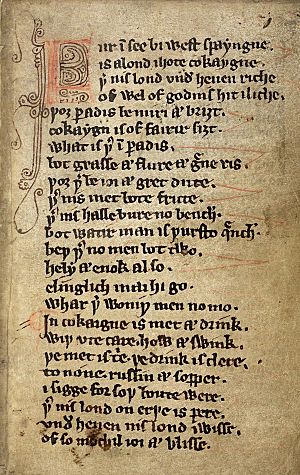Kildare Poems facts for kids
The Kildare Poems are a special collection of sixteen poems from the 1300s. They were written in a type of Middle English that was spoken in Ireland. Because of this, they are one of the first and most important examples of early Irish English.
The poems were found in a single old book, which is now known as Harley MS 913. They are a mix of serious religious poems and funny poems that make fun of things, which are called satires. The name "Kildare Poems" comes from the town of Kildare, where experts think the poems were written. One of the poets even called himself "Michael of Kildare."
Contents
History of the Poems
A Pocket-Sized Book
The poems are found in a small book made of parchment, which is a type of animal skin used for writing. The book was made around the year 1330. It's so small (about 14 by 9.5 cm) that it might have been a "pocket-book" for a traveling preacher.
It is believed that the authors were Franciscan friars, who were a group of religious men dedicated to a simple life.
Where Were They Written?
For a long time, experts have discussed where the poems were created. The two main places are Kildare in the east of Ireland and Waterford in the south.
- Why Kildare? One of the poems was written by "Michael of Kildare." Another poem mentions a knight named "Piers of Birmingham," who lived and was buried in Kildare.
- Why Waterford? A part of the book that is now lost mentioned the "yung men of Waterford." Also, the way some words are spelled is similar to the dialect spoken in that area.
A popular idea is that the poems were started in Kildare and then later copied and added to in Waterford.
Journey of the Manuscript
In the 1500s, the book was owned by George Wyse, who was the mayor of Waterford. Later, in 1608, an expert on old things named Sir James Ware studied the book and copied parts of it.
Eventually, the book became part of the huge library of Robert Harley, 1st Earl of Oxford and Earl Mortimer. In 1754, his library was given to the British Museum, where the book is kept safely today.
What Are the Poems About?
The poems show what the Franciscan friars thought was important. They often wrote about helping the poor and were critical of other religious groups that they felt were not living simply enough.
Here are some of the poems in the collection:
- The Land of Cokaygne: This is a famous satirical poem about a mythical land of luxury called Cockaigne. It makes fun of a group of monks who live a very easy and fancy life instead of a simple, religious one.
- Song of Michael of Kildare: A religious poem that is special because the author tells us his name: "Frere Michel Kyldare" (which means Brother Michael of Kildare).
- Sermons in Verse: There are several poems written like sermons, which are talks that teach a religious or moral lesson. They cover topics like the Fifteen Signs before Judgment and the Ten Commandments.
- Song of the Times: A poem that criticizes the social and political problems of the time. It includes a moral story about animals, called a fable.
- Piers of Bermingham: A poem written to honor an English knight, Sir Piers of Birmingham, after his death in 1308. It praises him for his battles against the Irish.
- Elde: A poem that talks about the difficulties of growing old.
A Unique Style of English
The English used in the Kildare Poems is fascinating for experts who study language. It's a mix of English dialects from the west of England, where many English settlers in Ireland came from. However, it also has special features that show how English was changing in Ireland.
Some of these unique features might be because of the influence of the Irish language. Here are a few examples of how their English was different:
- They sometimes swapped sounds, like using a "t" instead of a "th" sound.
- They often dropped the "h" sound at the beginning of words, writing is instead of his.
- They sometimes mixed up the order of letters in a word, like writing fryst instead of first.
- They added extra vowel sounds in the middle of words, like saying Auerill for April.
These poems give us a wonderful peek into the language and life of people in Ireland over 700 years ago.


